Knee pain can creep in from anywhere, an old injury, too many squats, or just wear and tear over time. But you don’t have to tough it out.
With the global knee brace market projected to hit 1.8 billion dollars by 2030, there’s no shortage of support options. The real challenge? Knowing which one actually works.
This definitive guide to the best knee braces for 2026 breaks it all down so you can find the right brace for your knees, your life, and your recovery goals.
Key Takeaways
-
Knee braces provide stability, protection, and support for both acute injuries and chronic conditions, enhancing recovery and preventing further joint damage.
-
Different types of knee braces, including hinged braces, compression sleeves, and custom options, are designed to meet specific medical needs based on the severity and nature of the knee issue.
-
While knee braces can significantly reduce pain and improve function, they also have limitations, including a potential false sense of security and the risk of muscle atrophy if not accompanied by complementary strengthening exercises.
What are Knee Braces For?
Knee braces are all about support. Whether you’re healing, managing pain, or staying active, the right brace can help take pressure off your joints and keep things moving smoothly.
They’re commonly used after injuries like ligament sprains or meniscus tears. In fact, experts say that knee braces help protect healing tissues and keep the knee from moving in ways that could slow down the recovery process.
If you have a chronic issue like osteoarthritis or knee cap pain, braces can help ease stress on the joint and improve your ability to walk or stay active. One clinical study found that using an unloader brace helped patients with knee OA walk farther with less pain.
After knee surgery, such as an ACL repair, doctors often recommend a specific brace to limit movement while the area heals. It can also help reduce complications and help you recover faster.
Even if you haven’t had surgery or a major injury, some people wear braces for stability. This includes anyone with loose joints, a history of dislocations, or a general sense that their knees require extra support during workouts. Pro athletes often use them as a preventive measure, too, although researchers are still debating their effectiveness.
How do Knee Braces Work?
Braces may seem simple, but they do a great deal behind the scenes.
Some are designed to limit movement physically. These are the rigid or hinged ones that can help stop your knee from bending the wrong way or twisting too far.
Others work more through compression. These soft, stretchy braces help reduce swelling by improving circulation. Athletic trainers often use them because the gentle pressure helps control inflammation, especially right after an injury.
And then there’s proprioception, your body’s ability to sense where it is in space. Wearing a brace, even a lightweight one, can give your brain better feedback about what your knee is doing. That extra awareness helps you move more confidently and avoid awkward, risky motions.
There are also specialized braces that shift pressure away from sore or damaged areas. This is especially helpful if you have arthritis in just one part of your knee. By redistributing the force, these braces help you walk more comfortably and with less pain.
So, depending on the design, a brace might limit motion, reduce swelling, improve muscle control, or all three at once.
Why Use A Knee Brace in the First Place?
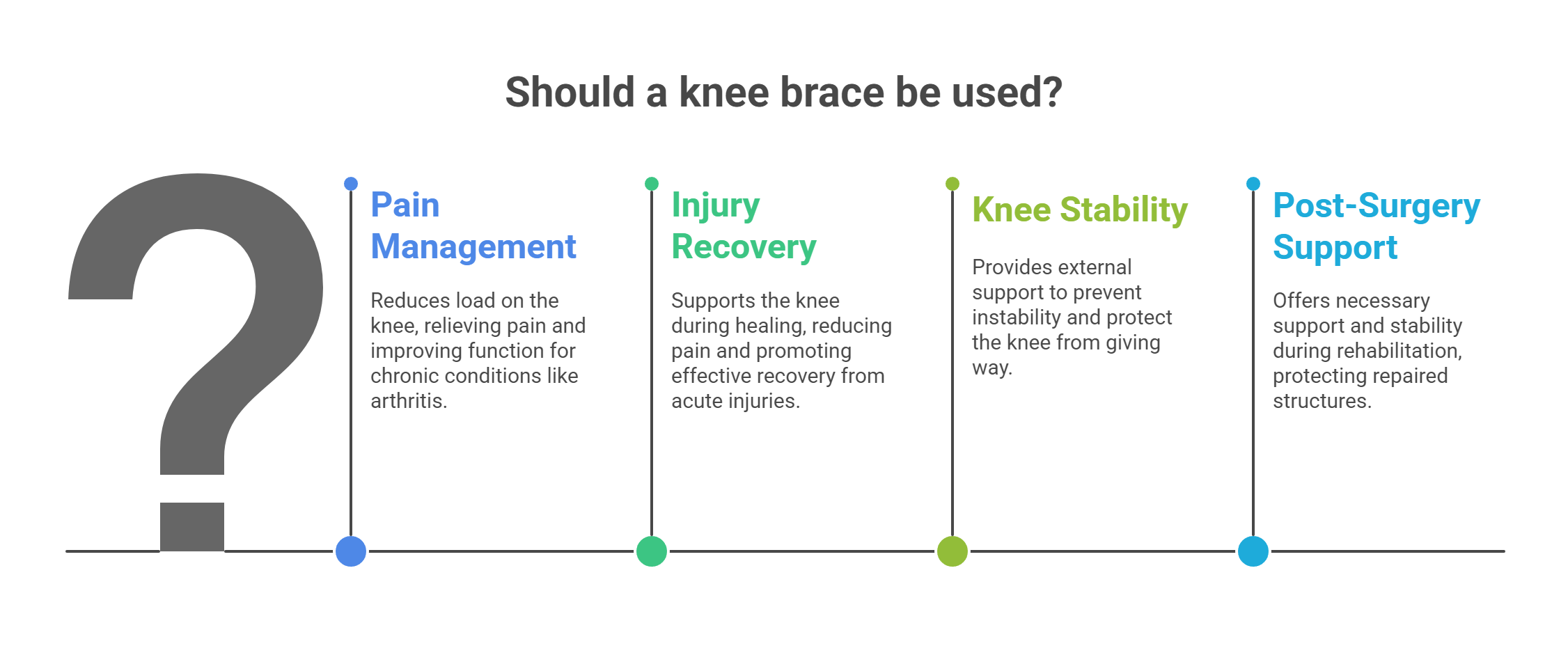
The use of knee braces is justified for several compelling medical reasons. Their application can significantly improve a patient's quality of life and recovery outcome across a range of scenarios.
Key applications include:
-
Pain management: For those suffering from chronic conditions such as arthritis, a knee brace can take some of the load during movements like walking or squatting. This offloading of the joint helps to relieve knee pain and improve function.
-
Injury recovery: After an acute knee injury, such as a sprain, strain, or tear, a knee brace can help support the knee while it heals. This creates a protected environment that can reduce pain and promote a more effective recovery.
-
Improving knee stability: For individuals with specific injuries that lead to knee instability, a brace provides crucial external support. This added stability protects the knee and helps prevent it from "giving way" during activity.
-
Post-surgery support: Following knee surgery, a surgeon typically prescribes a specific brace. This is done to provide the necessary support and stability needed during the delicate rehabilitation and recovery phase, protecting the repaired structures within the knee.
Types of Knee Braces
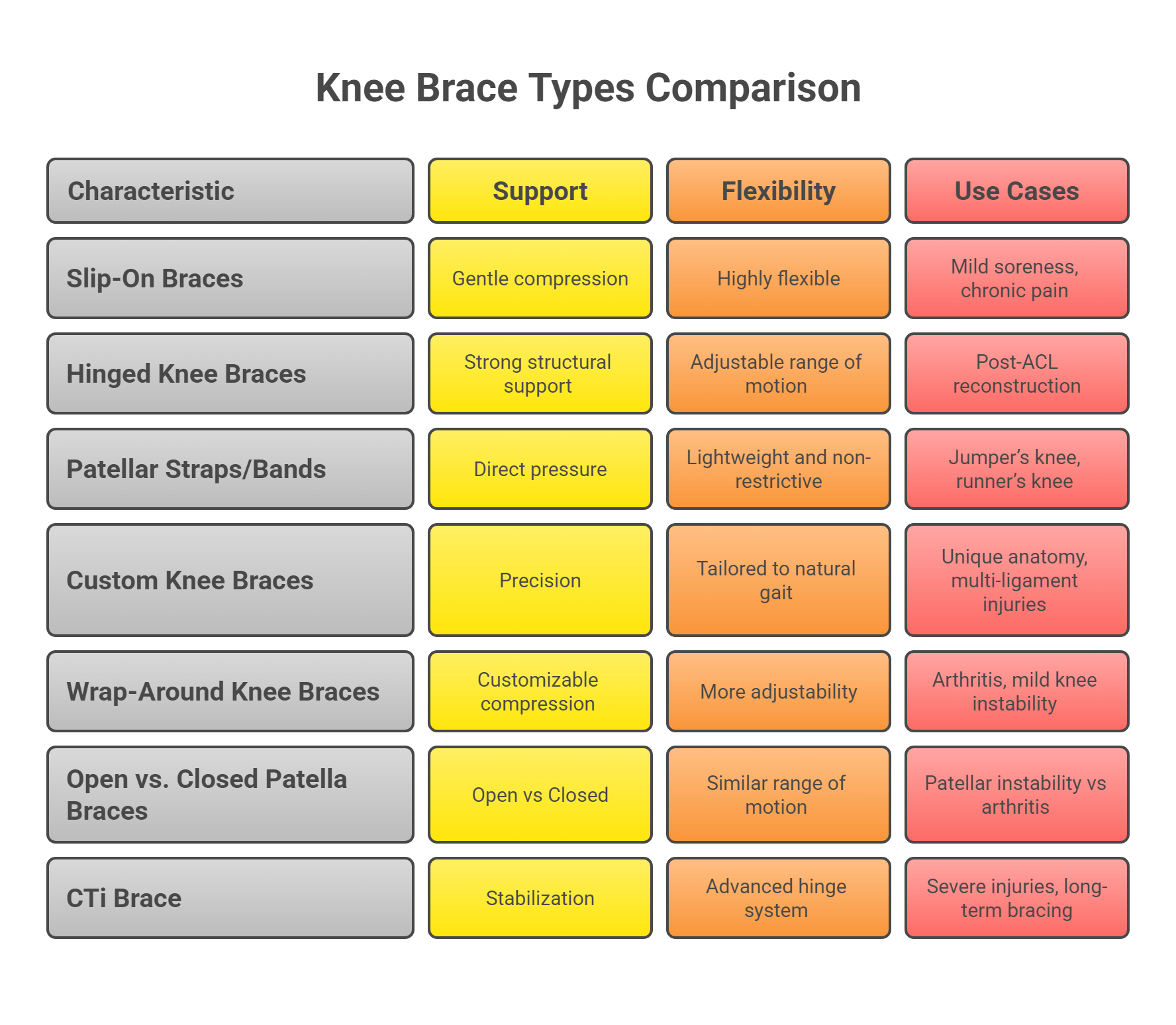
Not all knee braces are built for the same purpose. Each design supports the knee joint differently, from reducing knee pain to protecting against ligament injuries.
Understanding the different styles can help you choose the right knee brace for your needs.
Slip-On Braces (Compression Sleeves)
Slip-on braces, also known as compression sleeves, are a simple yet effective option for everyday support without bulk. These sleeves slide over the leg and provide consistent, light compression to the knee area.
-
Gentle Compression: It provides gentle compression that helps improve circulation, reduce swelling, and enhance joint alignment. According to a study published in Arthritis Research & Therapy, compression can lead to moderate improvements in pain and stiffness in people with early-stage knee arthritis.
-
Flexibility: Highly flexible and non-restrictive. These sleeves allow a full range of motion and are comfortable enough to wear throughout the day, even during workouts or long shifts on your feet.
-
Use Cases: Best for people with mild soreness, chronic pain, minor inflammation, or early knee joint degeneration. Popular among runners, walkers, and fitness enthusiasts.
The Anaconda Knee Brace dominates this category while adding a unique twist. It features an anti-slip design and gel padding for enhanced support during intense activity. So you can stay focused on your performance, protect your knees from strain, and move with total confidence.
Hinged Knee Braces
Hinged braces are designed to protect the knee from instability and prevent risky movements, particularly after injury or surgery. They include mechanical hinges on the sides to guide safe motion.
-
Structural Support: Strong structural support for the ligaments and surrounding tissues. These braces help reduce side-to-side motion and protect the knee from hyperextension, making them crucial for recovery from ligament injuries.
-
Flexibility: Some models allow an adjustable range of motion through dials or settings, while others lock the knee at specific angles. While more rigid than other braces, the best ones are engineered to follow the knee’s natural movement path without discomfort.
-
Use Cases: Recommended for post-ACL reconstruction, meniscus injuries, or severe instability. Athletes recovering from a torn ligament or undergoing physical therapy often rely on these for maximum support during high-stress rehab phases.
Patellar Straps and Bands
These minimalist braces target the area just below the kneecap, providing focused support to the patellar tendon. They are especially common among athletes with tendon overuse injuries.
-
Direct Pressure: Patellar straps and bands apply direct pressure to the patellar tendon to reduce tension and vibration during movement. This reduces pain in the front of the knee and helps support the tendon during repetitive strain.
-
Flexibility: Extremely lightweight and non-restrictive. These straps do not interfere with normal motion or muscle activation, making them ideal for active use.
-
Use Cases: Best suited for jumper’s knee, runner’s knee, and Osgood-Schlatter disease. Popular with basketball players, runners, and teens in sports where jumping is frequent. These can also be layered with compression sleeves for added comfort and knee support.
Custom Knee Braces
Custom braces are built using 3D scans or molds to create a personalized fit for the wearer. They are often prescribed by orthopedic specialists for complex or long-term conditions.
-
Precision: Custom-made knee braces offer precise joint stability and targeted reinforcement, especially in knees with abnormal alignment, post-surgical changes, or advanced degeneration. Custom construction helps avoid slippage or pressure points.
-
Flexibility: While not as flexible as a sleeve, these braces are tailored to move with the wearer’s natural gait. Due to their custom fit, they are often more comfortable than generic, rigid braces over the long term.
-
Use Cases: Ideal for individuals with unique anatomy, multi-ligament injuries, or those recovering from surgeries such as osteotomy or ligament reconstruction. They’re often necessary for people whose knees don’t respond to standard brace designs.
Wrap-Around Knee Braces
These braces open completely and fasten around the knee with straps. They offer a practical solution for individuals who struggle to pull on sleeves due to swelling or limited mobility.
-
Customizable Compression: Moderate support with customizable compression. Many wrap-around models feature soft stays or semi-rigid inserts for enhanced stability without stiffness.
-
Flexibility: Offers more adjustability than slip-on sleeves while remaining lightweight. The open structure allows the brace to adapt to changes in leg size from swelling or muscle gain.
-
Use Cases: Helpful for people with arthritis, mild knee instability, or post-injury swelling. The Anaconda Knee Brace uses a wrap design paired with anti-slip features, providing athletes with an easier fit that stays put during dynamic movements.
Open vs. Closed Patella Braces
These two designs differ in how they treat the area around the kneecap. Open patella braces leave the kneecap exposed, while closed ones cover the entire joint.
-
Open vs Closed: Open designs relieve direct pressure on the kneecap and help guide proper tracking. Closed designs create even compression throughout the knee, which can enhance warmth and circulation.
-
Flexibility: Both styles offer similar range of motion, but open patella models may feel cooler and lighter. Closed designs provide more consistent coverage and support.
-
Use Cases: Open braces are recommended for patellar instability, knee pain with tracking issues, or mild cases of chondromalacia. Closed styles work well for arthritis, swelling, and general knee support needs.
CTi Brace (by Össur)
The CTi Brace is widely used by elite athletes recovering from serious ligament injuries. Its carbon fiber frame delivers unmatched protection and long-term durability.
-
Stabilization: Maximum stabilization for the ACL, PCL, MCL, and LCL. It shields the knee from twisting or hyperextension that could compromise healing or performance.
-
Flexibility: Though rigid, the CTi uses an advanced hinge system that aligns with the knee’s natural pivot point. This allows for smoother motion compared to older bracing designs.
-
Use Cases: Ideal for motocross, snowboarding, skiing, and contact sports. Used after severe injuries or when long-term bracing is needed for prevention. For athletes in less extreme conditions, the Anaconda Knee Brace offers a lightweight alternative that delivers strong knee support without sacrificing mobility.
Key Factors in Choosing Your Knee Brace
Picking the right type of knee brace depends on your goals. Whether it’s for ACL surgery recovery, daily light support, or help during physical therapy, the right choice can improve comfort, stability, and recovery.
Here are the key things to look for:
|
Factor |
What to Look For |
|
Support Level |
Match the brace to your needs. Use mild support for soreness or general use, and more support for instability, injury, or post-ACL surgery recovery. |
|
Fit and Sizing |
A poor fit can cause slipping or restrict motion. Look for clear sizing charts, adjustable features, and Velcro straps that help you get a secure, flexible fit. |
|
Comfort |
Comfort matters, especially if worn for an extended period. Look for braces that avoid rubbing or pressure spots and help manage pain effectively. |
|
Material & Breathability |
Breathable knit materials boost blood flow and reduce moisture. Neoprene retains warmth. Choose based on how much heat or airflow you need. |
|
Ease of Use |
Braces with Velcro straps are easier to put on and adjust. Wrap-around styles work well if swelling or stiffness makes sleeves difficult to wear. |
|
Build Quality |
A quality brace should last. Strong stitching and durable components are important, especially during active use or physical therapy. |
|
Value |
Features like extra support, compatibility with unloader braces, or targeted relief should match the cost. The best value comes from braces that last. |
Best Knee Braces for Specific Conditions
Different knee issues call for different levels of support and brace designs. The right knee brace can improve daily mobility, reduce knee pain, support healing, and even prevent further injury.
Each recommendation here focuses on a specific condition, with evidence-backed reasoning, clinical claims, and a unified format to help you find the best fit.
Best Brace for Osteoarthritis
Osteoarthritis (OA) is the most common form of arthritis and affects over 32.5 million adults in the US, according to the CDC. It involves the breakdown of cartilage in the knee joint, leading to stiffness, pain, and limited movement. Braces designed for OA either provide compressive warmth or redistribute pressure to less damaged areas.
Research published in The Surgery Journal found that unloader braces can significantly reduce pain and improve function for people with unicompartmental OA. These braces help offload pressure from the worn-out side of the knee. For early-stage OA or milder symptoms, compression sleeves can increase blood flow and improve joint alignment, which has shown benefits in symptom relief and long-term joint health.
Look For:
-
A brace designed to address the breakdown of joint cartilage, which leads to pain, stiffness, and reduced mobility.
-
For moderate to severe cases, an "unloader" brace can shift pressure from the painful, damaged part of the joint to the healthier side.
-
For mild OA, a soft compression sleeve that is effective at providing warmth and support to manage symptoms.
-
A choice that is directly dependent on the severity of the condition.
Editor’s Choice: Anaconda Knee Brace
This hybrid support brace provides compression, stability, and impact protection, making it a practical solution for early to moderate OA.
Runner-Up: DonJoy OA FullForce
Clinically proven with a 3-point leverage system that reduces pressure on the affected joint. Unlike the Anaconda, it’s more rigid and best for advanced cases.
Honorable Mention: Bauerfeind GenuTrain A3
Uses medical-grade compression and a viscoelastic pad for pain relief in mild to moderate OA. Ideal if you want less bulk than unloader braces.
Best Brace for Chronic Knee Pain
Chronic knee pain is a broad term that includes a range of mild to moderate conditions that persist for three months or more. The ideal brace for general, persistent pain provides a comfortable balance of compression for pain relief, light support for stability, and breathability for all-day wear without being overly restrictive or bulky.
Look For:
-
A comfortable balance of compression for pain relief and light support for stability.
-
Breathable, moisture-wicking material suitable for all-day wear.
-
A design that provides a sense of security without being overly restrictive or bulky.
-
Features like anti-slip grips to prevent the brace from sliding down during activity.
Editor's Choice: Shock Doctor Knee Compression Sleeve w/ Open Patella
This brace is consistently recommended for its outstanding versatility and comfort in managing daily knee pain. It provides firm, medical-grade compression to help reduce swelling and features an open-patella design to relieve direct pressure on the kneecap. Its breathable, moisture-wicking fabric and anti-slip silicone grippers make it a reliable choice for all-day wear and consistent pain management.
Runner Up: Bauerfeind GenuTrain S
For chronic pain that is accompanied by mild to moderate instability, the GenuTrain S is a significant step up from a basic sleeve. It cleverly integrates hinged sidebars into a medical-grade compression knit fabric. This design provides valuable side-to-side stability to prevent the knee from giving way, while remaining comfortable enough for extended periods of use.
Honorable Mention: Anaconda Knee Brace
This hybrid brace is an excellent option for active individuals managing chronic pain or instability. It uniquely combines high compression for pain relief and improved recovery with adjustable stability straps that allow users to add targeted reinforcement. This design provides a more secure and confident feeling during movement without restricting the range of motion, making it ideal for those who need support but want to remain active.
Best Brace for ACL Injuries
ACL injuries are among the most severe knee injuries, often requiring surgery and a long recovery. Braces for ACL damage must offer high structural support and prevent rotation or hyperextension.
A systematic review published in the Journal of the Pediatric Orthopaedic Society of North America confirmed that functional ACL braces can reduce graft strain and improve return-to-sport confidence post-ACL surgery. The brace must provide anterior tibial control without limiting mobility too much.
Look For:
-
Maximum stability from a rigid frame made of materials like carbon fiber or aircraft-grade aluminum.
-
A specialized functional hinge system designed to control hyperextension and prevent anterior tibial translation.
-
A secure, low-profile fit, either from a custom mold or a high-quality off-the-shelf design, to prevent rotation and slippage during activity.
-
Clinically proven technology designed specifically for ACL protection.
Editor’s Choice: DonJoy Defiance III Custom Brace
Industry gold standard with a 4-point leverage system and perfect fit via custom mold.
Runner-Up: DonJoy Armor with FourcePoint Hinge
An off-the-shelf version offering high-level ACL protection. Unlike Anaconda, it's not designed for everyday mobility but excels at high-impact protection.
Honorable Mention: Bauerfeind SecuTec Genu
Offers excellent control for post-operative ACL support with adjustable hinges.
Best Brace for Meniscus Injuries
Meniscus tears can result from twisting or squatting and are often aggravated by poor joint alignment. Braces that control lateral movement and offload pressure are key.
According to a study in Prosthetics and Orthotics International, patients with meniscal tears saw improved function and reduced pain when using braces with unloading and stabilizing features. Hinged designs are best post-surgery, while milder tears benefit from soft, stable supports.
Look For:
-
A hinged brace that provides medial-lateral (side-to-side) stability to protect the joint.
-
A design that effectively prevents the harmful twisting motions that can worsen a tear.
-
For tears associated with osteoarthritis, a brace with an "unloader" feature is highly beneficial.
-
For post-operative recovery after a meniscus repair, a brace that offers maximum stability and a controlled range of motion is essential.
Editor’s Choice: Bauerfeind GenuTrain OA
Offers unloading and side stabilization in one sleek design.
Runner-Up: DonJoy Playmaker II
Hinged and breathable with strong medial-lateral control. Less customizable than Bauerfeind.
Honorable Mention: Breg Recover Knee Brace
Ideal for post-op recovery. Allows adjustable range of motion.
Best Brace for Patella Injuries
Patella injuries include tendonitis, improper tracking, or instability. Effective braces reduce stress on the tendon or guide the kneecap.
Research in Sports Health shows patellar straps can reduce pain in tendonitis by dispersing force on the patellar tendon. Proper kneecap alignment prevents long-term cartilage wear and improves performance.
Look For:
-
For Patellar Tendonitis, a minimalist strap that applies targeted, adjustable pressure directly to the patellar tendon.
-
For Patellofemoral Pain Syndrome, a brace featuring a buttress (a foam or gel pad) designed to guide the kneecap and improve tracking.
-
An open-patella design to relieve direct pressure on the kneecap itself.
-
A solution that is highly specific to the diagnosed injury (tendonitis vs. mal-tracking).
Editor’s Choice: DonJoy Tru-Pull Lite
Dual-strap system pulls the kneecap into proper alignment.
Runner-Up: Ultimate Performance Patella Strap
Targets tendon loading pain with minimalist design.
Honorable Mention: Cho-Pat Original Strap
Classic solution for tendonitis relief. Lacks the adjustability of newer models.
Best Brace for Trauma and Post-Surgery
Post-traumatic or post-surgical knees need maximum support and motion control during recovery. These braces prevent weight-bearing and unsafe motion.
A randomized trial published in the National Library of Medicine emphasized the role of ROM (range of motion) braces in improving post-surgical outcomes. Adjustable hinges reduce strain and improve healing compliance over time.
Look For:
-
A design that offers complete immobilization or strictly controlled movement.
-
A high-quality, adjustable dial-in hinge that can be locked at specific angles.
-
Long, rigid sidebars that extend from the thigh to the calf for maximum stability.
-
A brace specifically designated as "rehabilitative" or "post-operative," often prescribed by a surgeon.
Editor’s Choice: Breg Recover Knee Brace
-
Excellent for rehab with full immobilization and range locking.
Runner-Up: Brace Direct Post Op ROM Hinged Brace
-
Telescoping feature fits a wide range of users. Lacks some padding comfort.
Honorable Mention: Ergoactives ErgoBrace
-
Lightweight alternative for extended use under clothing.
Best Brace for Injury Prevention and Athletic Use
These types of braces are designed to help athletes prevent potential knee injuries during high-impact sports or rigorous training. Rather than treating an existing issue, they aim to reduce the likelihood of strain, impact-related damage, or joint instability before it occurs.
A study published in the Orthopedic Journal of Sports Medicine found that prophylactic bracing reduced joint acceleration during medial and lateral center impacts. It also altered ACL strain responses, decreasing strain during medial superior impacts, though it increased strain with anterior inferior ones.
Look For:
-
A balance of support and flexibility that doesn't restrict athletic performance.
-
Reinforcement against dangerous or abnormal joint movements.
-
A design that permits a full, natural range of motion for complex activities.
-
High compression to enhance proprioception and muscle awareness.
Editor’s Choice: Anaconda Knee Brace
An ideal fit for athletes seeking both freedom of movement and proactive protection. The Anaconda’s compression layer enhances proprioception, while its dual strap system keeps the brace snug without restricting range. It's a strong choice for preventing common joint strains during MMA, CrossFit, or high-impact sports.
Runner Up: McDavid VOW Versatile Over Wrap
This wraparound brace includes spring steel side stays and adjustable straps, providing decent reinforcement. However, it lacks the same gel impact zones and contour-fit compression of the Anaconda, which makes the latter more adaptable to fast-paced environments.
Honorable Mention: Bauerfeind Sports Knee Support
Light and breathable, it boosts proprioception with firm knit compression. Unlike the Anaconda, it doesn’t offer mechanical reinforcement or directional control, but it’s an excellent option for athletes with minor instability seeking added awareness during motion.
What To Consider When Choosing A Knee Brace
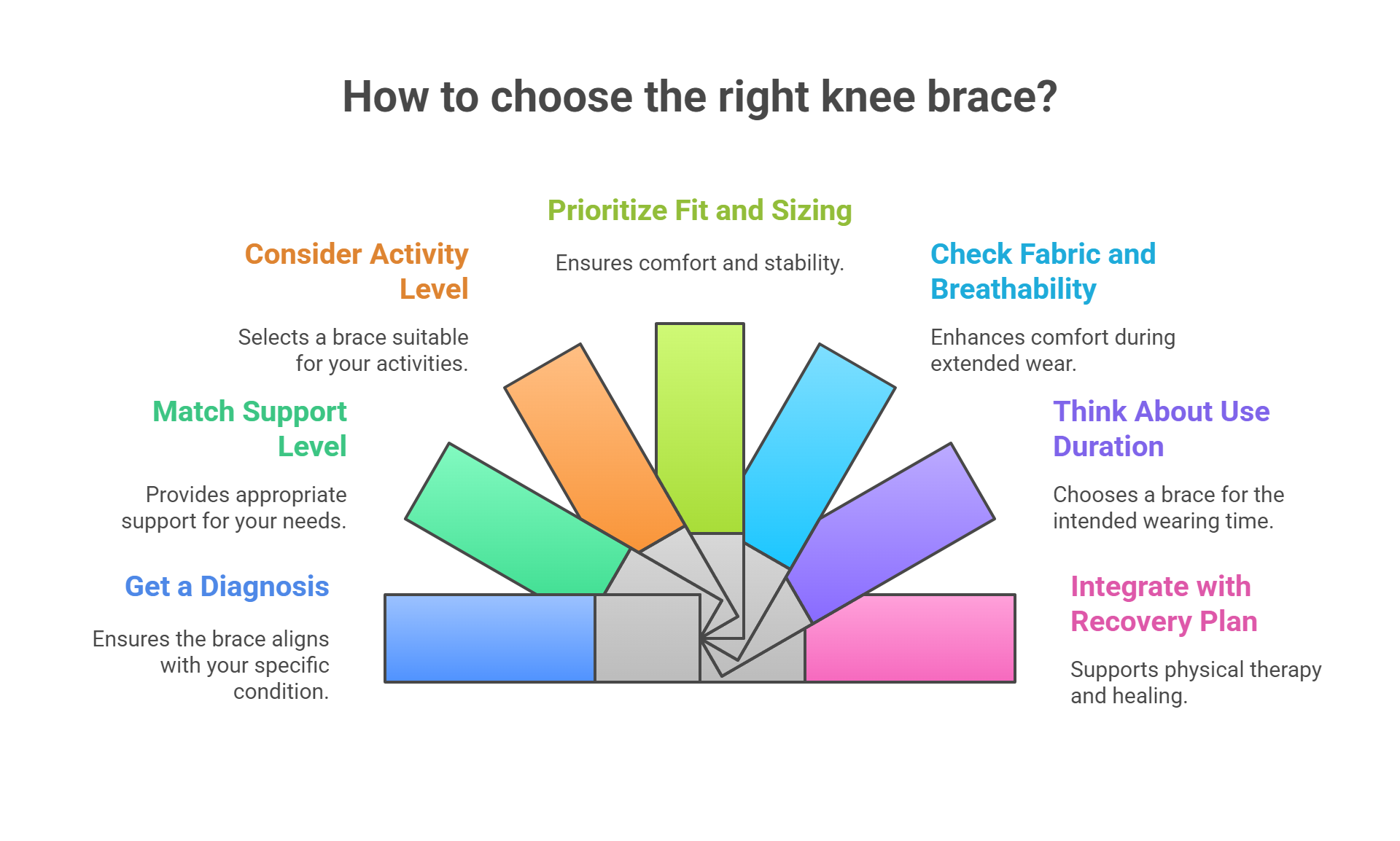
Before you click “add to cart,” it’s important to know that not all knee braces are created equal. From injury recovery to daily wear, the right brace depends on your condition, activity level, and comfort needs.
Here's what to keep in mind to make sure you're choosing the best fit for your knees:
-
Get a Diagnosis First: Speak with a healthcare provider to ensure you're selecting a brace that aligns with your specific condition. Whether it’s an ACL injury, patellar instability, or arthritis, professional input helps match you with the right type of knee brace and avoid unnecessary setbacks.
-
Match the Support Level to Your Needs:
-
Mild support: For day-to-day aches or mild inflammation
-
Extra support: When dealing with instability or returning to sport
-
Maximum support: For post-op recovery like ACL surgery, or managing severe instability with controlled movement
-
-
Consider Your Activity Level: Are you using it for work, daily tasks, or playing sports? High-impact activities call for braces with side stabilizers, Velcro straps, and a snug secure fit that offers targeted relief without restricting motion.
-
Prioritize Fit and Sizing: A poor fit can cause more harm than help. Braces that are too tight may restrict blood flow; too loose and they won’t provide stability. Look for options with adjustable straps, wrap-around designs, or a customized fit to keep swelling in check and ensure support.
-
Check the Fabric and Breathability:
-
Knit fabric enhances airflow and helps improve circulation during extended wear
-
Neoprene retains warmth, which may help manage pain and stiffness
Choose based on how long you’ll wear the brace and whether heat or airflow is more important for your condition.
-
-
Think About Use Duration: Will you wear it only during workouts or throughout the day? Braces designed for an extended period of use should focus on breathability, comfort, and balanced support.
-
Make It Part of a Bigger Plan: A brace works best when it supports, not replaces, your physical therapy or recovery routine. Combine it with strength work and medical guidance to improve function, reduce swelling, and support the healing process.
Pro Tip: Don’t treat your brace like a standalone solution. When combined with a tailored treatment plan, it can help provide support, speed up recovery, and even prevent injuries before they start.
Benefits and Limitations of Knee Braces
Knee braces can be an essential part of managing knee pain, promoting recovery, and improving function. But they’re not a magic fix. Understanding both the strengths and shortcomings of bracing can help you set realistic expectations and choose the right support strategy.
Benefits
When used correctly and combined with a proper treatment plan, knee braces can significantly improve day-to-day knee function. They offer compression to reduce swelling, improve blood flow, and relieve pressure on sensitive structures. Rigid and unloader braces in particular can improve biomechanics by redistributing weight and providing stability, which leads to:
-
Better neuromuscular control
-
Enhanced proprioception and dynamic stability
-
Increased confidence in movement
-
Lower perceived risk of re-injury during activity
Athletes and post-surgical patients often report greater security and performance with well-fitted braces designed for targeted relief.
Limitations
Despite their many advantages, knee braces have boundaries. They are not a replacement for physical therapy, strength work, or long-term joint health strategies. Scientific reviews suggest that prophylactic braces (those used to prevent injuries) may not significantly reduce the risk of initial ACL or ligament injuries in high-load sports environments.
Key limitations include:
-
They may create a false sense of security, increasing the risk of overexertion
-
Prolonged use without muscle strengthening may contribute to muscle atrophy
-
Heavier braces may feel restrictive and reduce agility or comfort
In other words, a brace should complement, not replace, your rehab or training plan.
Fit and Care
Even the best-designed brace is only as good as its fit. Ill-fitting braces can cause discomfort, restrict motion, or even worsen instability. Here’s how to ensure proper sizing and care:
-
Measure your knee, thigh, and calf circumference as per the manufacturer’s guide
-
The brace should be snug but not overly tight, use the two-finger test to confirm
-
Hinges should align with your knee joint’s natural pivot point
When it comes to care:
-
Hand-wash knit fabric or neoprene components with mild soap and lukewarm water
-
Air-dry only, never place braces in a dryer
-
Regularly check Velcro straps, hinges, and liners for wear or damage
A well-maintained brace will continue to provide support and maintain a secure fit over time.
Cost of Knee Braces
Brace pricing varies widely depending on materials, features, and customization level:
-
Compression sleeves and straps: $15 to $80 (ideal for light support and pain relief)
-
Wraparound or soft hinged braces: $50 to $150 (offer additional support for mild instability)
-
Rigid functional braces: $500 to $1,000 (used post-ACL injury or for serious conditions)
-
Custom knee braces: $1,000 to $2,000 (made for long-term use or complex anatomical needs)
Anaconda Knee Brace starts at just $49.95 for a single brace and is available in sizes from XS to XXXL. It’s a versatile option for athletes and everyday users alike, with or without side stabilizers. You can also bundle and save, get two Anaconda braces for just $59, or four for $99.
Pro Tip: Get 2 Anaconda Knee Braces for only $59 and save 40 percent. That’s extra support for both knees, or a backup for training days.
Does Insurance Cover Knee Braces?
In many cases, yes, but there are requirements. Most insurance plans (including Medicare and private carriers) offer partial or full reimbursement for medically necessary braces when:
-
You have a prescription from a healthcare provider
-
Documentation supports medical necessity (for example, post-ACL surgery or unloader braces for arthritis)
-
You work with an approved Durable Medical Equipment (DME) supplier
Keep in mind, coverage often includes deductibles and co-insurance. What’s “covered” doesn’t mean it’s completely free.
Choosing The Right Knee Brace For You
It all starts with clarity. Getting an accurate diagnosis allows you to target the right type of knee brace, whether that means light support for mild soreness or rigid bracing for post-surgical recovery.
Remember, the more support a brace provides, the more it can limit mobility. A sleeve might be perfect for long walks, while a rigid frame is necessary after reconstructive ACL surgery. Finding the right brace is about striking the best possible balance between mobility and stability for your specific goals.
Important note: Don't skip the rehab. Even the most advanced brace won't replace the value of strength training, mobility work, and consistent physical therapy. Bracing should fit into a bigger strategy to improve long-term joint health.
Final Words
Knee braces remain one of the most effective ways to manage common knee conditions like osteoarthritis, ligament injuries, and chronic knee pain. The right brace can ease discomfort, support joint function, and boost confidence in movement.
Whether you’re recovering from an injury or protecting your knees during training, consistency matters. Pairing your brace with physical therapy and strength work can dramatically improve long-term results.
For many active individuals, the Anaconda Knee Brace strikes the perfect balance of comfort, support, and flexibility. Its gel padding, compression design, and non-slip straps make it a go-to for athletes and everyday users who want reliable protection without sacrificing mobility.
Frequently Asked Questions
Still have questions? Here are some quick answers to help you make the right choice.
What type of knee brace is best for osteoarthritis?
An unloader brace is best for moderate to severe osteoarthritis, while a soft compression sleeve is effective for mild cases. Choose the appropriate type based on the severity of your condition.
How do knee braces help with chronic knee pain?
Knee braces help alleviate chronic knee pain by providing compression for pain relief and light support for stability, which enhances comfort and function. This combination can significantly improve your mobility and daily activities.
Are custom knee braces worth the investment?
Custom knee braces are worth the investment as they offer a precise fit and superior support, particularly beneficial for those with ligament instabilities or recovering from surgery. Their effectiveness can greatly enhance mobility and comfort during recovery.
Can knee braces prevent sports injuries?
Knee braces can offer stability and support during sports, but there is insufficient evidence to confirm they prevent initial injuries effectively. It's essential to combine them with proper training and techniques for optimal safety.
How should I care for my knee brace?
To properly care for your knee brace, hand wash the fabric components with mild soap and cool water, ensuring you rinse them thoroughly and air-dry. Additionally, regularly inspect the straps, Velcro, and hinges for any signs of wear or damage.



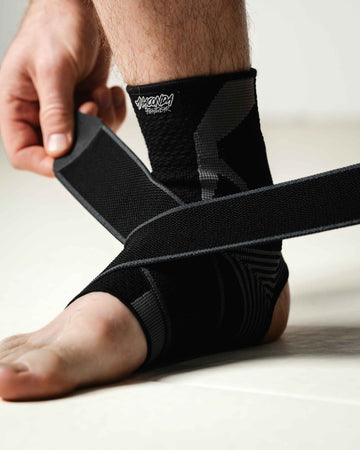



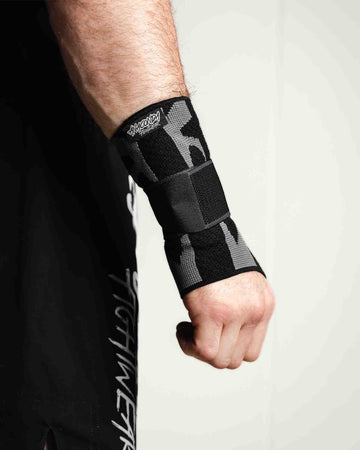

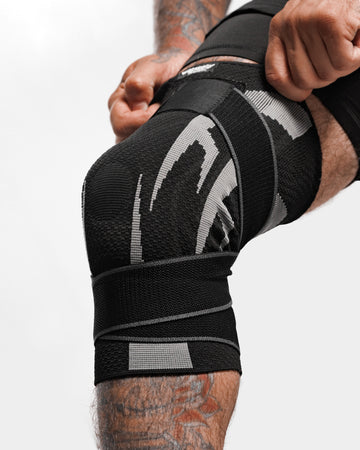



![How Long Does a Knee Injury Take to Heal? [Essential Insights and Tips]](http://anacondafightwear.co/cdn/shop/articles/How_Long_Does_a_Knee_Injury_Take_to_Heal.jpg?v=1764885786&width=533)
